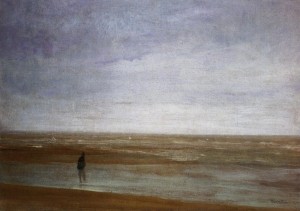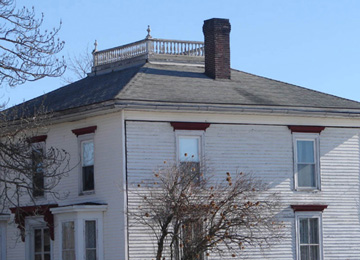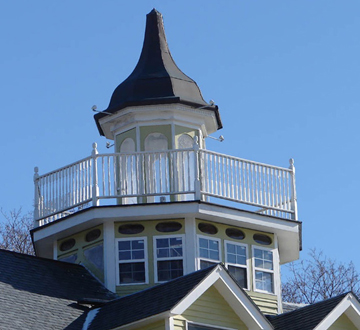
Legend has it a wife spend endless hours watching the horizon of the sea for her ship’s sail to appear.
Any trip through Cape Cod, Nantucket and other local coastal towns is a tour through the 19th century cultural landscape of New England — an architectural intersection between its British inheritance and the stylistic dictates of a New World. Widow’s Walks are platforms nestled in the high gables of peaked roofs, though they vary in size, ornamentation and functionality depending on their place in history. Widow’s Walks first emerged from the vague mists of folklore; purportedly, they were observation decks for wives to survey the horizon for their husband’s return from sea.
“The faithful and dedicated wife, performing her daily circumambulations on the cold and lonely widow’s walk: The next sail to top the horizon may well carry her husband, gone to sea these many years. But not today. The sun sets, bringing to a close her lonely vigil for this day. Perhaps, though, the much-anticipated vision will appear tomorrow and if not tomorrow, the next day.” via.
This mythology has distinct Victorian overtones, from the pining, obedient wife to the grim sentimentalism of a lost love. Despite the quixotic narrative, these architectural features were far more practical than Romantic in nature. Early Widow’s Walks were simply a hatch opening on the top of a roof next to the chimney, where a small landing was encircled by a wrought iron rail. Before the advent of electricity and centralized heating, people kept fires going indoors throughout the cold New England winters, and accidents were of primary concern to a household. Buckets filled with sand or water were kept by the hearth and, at the onset of a emergency, could easily be used to douse a raging chimney fire through this access point.
New England transformed from a fledgling colony to a contending industrial economy, and the architecture of newfound wealth became increasingly grander. Widow’s Walks were aesthetic statements, the bannistered crown on top of a palatial home, which could also be opened to air the stuffy top floor during humid summers. These belvederes wound up entertaining more cocktail parties than lachrymose widows as they expanded to accommodate larger crowds. Ornate cupolas and other surplus flourishes were added to beautify the space, and ‘keep up with the Joneses.’ Real estate agents caught wind of their potential to add an ocean view to houses that were not immediately seaside, so Widow’s Walk continued to be included in newer homes through the 20th century. The stylistic development of Widow’s Walks was more aligned with the practical and recreational needs of a household than the macabre, and almost Odyssean character, of their namesake.
All photos by Philip Seymour.
Further Reading:
A stunning crematorium by Maki and Associates in Japan offers a space for reflection.
A video tour of Nantucket’s Widow’s Walks.
Learn more about historic New England architecture.
Related Articles:
- The Widow’s Walk (emmasmith0213.wordpress.com)

 The Historical Widow’s Walk, Where A Wife Waited for Her Husband’s Safe Return From Sea
The Historical Widow’s Walk, Where A Wife Waited for Her Husband’s Safe Return From Sea




 “As Tears Go By” by Marianne Faithfull
“As Tears Go By” by Marianne Faithfull
 “The Sea” by John Banville
“The Sea” by John Banville
 Funeral Favors Offer Visitors a Tangible Memento
Funeral Favors Offer Visitors a Tangible Memento















